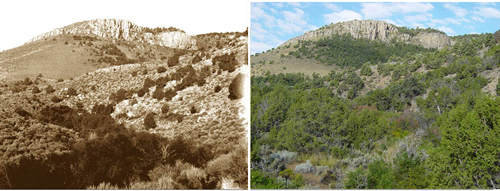
Comparison photographs taken at Flyn Springs shows encroachment of pinon-junipers over the last 80 years
Trouble in the Ruby Mountains
By Larry Hyslop

Comparison photographs taken at Flyn Springs shows encroachment of pinon-junipers over the last 80 years
Recent research shows small mammal populations are dropping in the Ruby Mountains. The numbers of small mammals have dropped by half since a similar study was conducted during the 1920s.
In 1927-1929, University of California ecologist, Adrey Borell, recorded numbers and species he trapped at 15 sites in the Rubies. As part of the Great Basin Re-survey Project, funded by the National Science Foundation, University of Utah biologist Rebecca Rowe and crew repeated this survey. During 2006-2008, they placed traps and recorded the numbers, species and statistics of captured small mammals. Rebecca’s crew surveyed 22 sites, of which 9 were the same sites used by Borell.
They also compared historical photographs against modern day photos to look for changes in vegetation. Weather data was analyzed to see how the climate has changed.
Borell’s original survey found 1,408 animals of 19 species, including mice, voles, shrews, chipmunks, woodrats and others. Rowe’s re-survey found 592 animals of 17 species, from a similar number of set traps.
A study of weather records found the Rubies have warmed slightly, both in the summer maximum temperatures and winter minimums. Precipitation has also risen slightly. Comparing historic photographs with recent ones taken at the same location reveal changes in vegetation. Often, woody species have invaded, such as pinon-juniper, along with the inevitable cheatgrass.
Changes in vegetation are due to changing land use, invasive alien plants and climate change. Reductions in animal numbers were observed to be most extreme at low elevations that would have seen the most warming and changes in vegetation, but reductions were also apparent at higher elevations where vegetation cover has been the most stable.
I asked Rebecca Rowe if her study could have been simply conducted during a few bad years for small mammals. She feels that since the results remained the same over the three years of the study and over the 22 sites studied, the results are valid.
Two interesting facts came out in the results. Species of small mammals would be expected to move up in elevation in response to warming temperatures but most species have not. The research results show the vegetation upslope may have changed enough to prevent this movement. The species affected the most were the specialists in vegetation types, while the generalists were the least affected.
The original survey was done at a time of heavy grazing in the Rubies, much more than seen during the re-survey. The Rubies in the 1920s had fewer mule deer and no bighorn sheep.
The researchers feel their results show land-use changes, along with climate change, have reduced and changed the types of vegetation needed by these small mammals for their livelihoods.
Elko Daily Free Press, “Nature Notes”, 8/11/2011 © Gray Jay Press, Elko, NV
Return to Elko Nature Notes